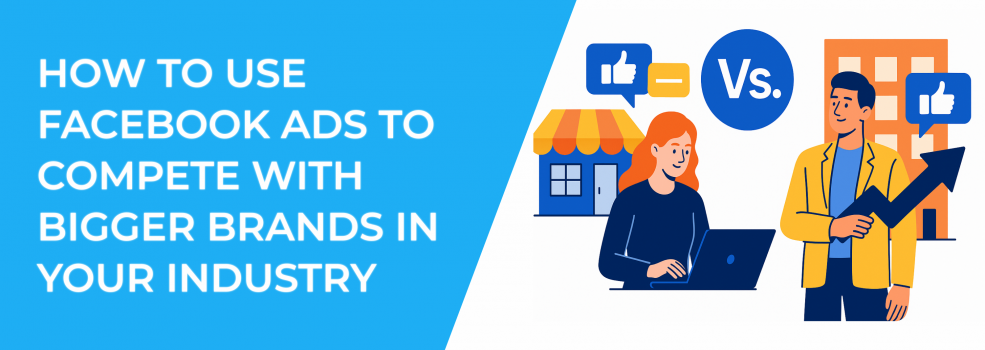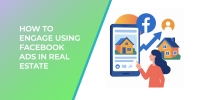It’s no secret: big brands have big budgets. But that doesn’t mean small businesses are out of the game.
Facebook and Instagram Ads give you something most platforms don’t — precision. And with the right strategy, you can reach high-value customers without spending like a giant.
In this article, we’ll break down how small businesses can use Facebook Ads to compete (and even win) against bigger brands — by being faster, smarter, and more focused.
Why Facebook ads still work for small businesses
You might be thinking, “Can I really compete with companies spending 100x more than me?”
The answer is yes, but if you have a good strategy.
Big brands often run broad campaigns with generic messaging. They rely on reach, but you can focus on relevance.
Facebook gives you powerful targeting, detailed performance data, and full creative control. That’s everything you need to run high-performing campaigns — without burning through your budget.
And when you zoom in on specific, high-intent segments, your ads start doing more with less. That's the real advantage.
Target the right people, not the most people
Trying to reach “everyone” is a fast way to waste money.
Start small and specific. Define who your ideal customer actually is — not just demographically, but behaviorally. What are they looking for? What do they care about? Where do they spend time?
Once you’ve got a clear idea, use Facebook’s targeting tools to get in front of them.
Here’s how:
-
Use custom audiences. Retarget people who already know your brand — website visitors, Instagram engagers, video watchers, or past customers. These people are more likely to convert.
-
Create lookalike audiences. Start with your top customers (not just your whole email list). Build lookalikes based on people who actually buy, not just browse.
-
Narrow with interests and behaviors. Don’t stop at broad interests if that's not working for you. Combine interests. Layer behaviors like “engaged shoppers” or “frequent travelers” to find people who take action.
-
Use geo-targeting wisely. If you’re local or know certain cities convert better, focus your budget there. Run tests by location to see where your best customers are.
Tip: avoid targeting overlaps. If multiple ad sets target similar groups, you’ll compete against yourself and drive up your costs.
Once your targeting is dialed in, you’ll notice a shift: better clicks, lower CPCs, and more conversions even on a modest budget.
With LeadEnforce, you can take Facebook ads targeting even further.
Instead of relying only on Facebook’s built-in audience tools, LeadEnforce lets you create custom audiences using actual members of Facebook communities — even those following your competitors. That means you’re reaching people who already show strong interest in your niche.
If you’re ready to:
-
Reach people who are more likely to convert,
-
Reduce wasted ad spend,
-
Target with laser-sharp accuracy,
-
Compete directly with brands 10x your size.
Then LeadEnforce can help you do just that.
Want to try it for yourself? Start here.
Create ads that look and feel real
Big brands often use polished, professional ads. That’s not always a good thing.
People scroll past ads that look like ads. As a small business, your edge is authenticity. When your ad looks like it was made by a real person, it stops the scroll.
Try this:
-
Record a short video on your phone. Talk directly to the camera. Explain a problem, then show how your product solves it. Be yourself — it builds trust.
-
Show real use cases. Use customer testimonials, behind-the-scenes clips, or real-life demos. Make the viewer think, “That’s me.”
-
Use text overlays and captions. Most people watch videos without sound. Make sure they understand your message instantly.
-
Test multiple creatives. Run 3-5 versions with different hooks or visuals. Let the algorithm find what works best.
Example: instead of just saying “Our candles are 100% soy,” show someone lighting one in a cozy kitchen and relaxing after work.
Authentic content breaks through the noise. You don’t need a film crew, just a relatable message that makes someone pause and think, “This could help me.”
Curious how to grab attention fast? Learn the psychology behind scroll-stopping Facebook Ads.
Build a simple funnel, then optimize it
Many small businesses run one ad and hope it converts. That’s like proposing on the first date. It rarely works.
Instead, build a lightweight funnel — a clear path from first touch to final conversion.
Here’s a simple funnel you can build:
-
Top of Funnel (Awareness)
-
Target cold audiences with videos, reels, or carousel posts.
-
Goal: get engagement — video views, clicks, post reactions.
-
-
Middle of Funnel (Consideration)
-
Retarget people who watched your videos or clicked your ads.
-
Show product benefits, reviews, or FAQs.
-
Goal: get site visits or add-to-carts.
-
-
Bottom of Funnel (Conversion)
-
Retarget people who visited your product page or added to cart.
-
Use urgency (“Only 3 left!”) or discounts (“10% off for new customers”).
-
Goal: drive purchases or signups.
-
Tip: use Facebook’s custom conversions to track key steps, like visits to your checkout page or completed lead forms. You don’t need a complicated marketing machine. Just a few thoughtful steps that bring people closer to buying.
Choosing the right objective at each stage is critical — this guide to Meta campaign objectives walks you through how to do it right.
Move quickly and test often
Big brands move slow. You don’t have to. Your advantage is speed.
You can respond to trends, feedback, or poor performance immediately without waiting on approvals or committee meetings.
-
Launch tests fast. Don’t overthink your first version. Publish, learn, and tweak. The data will tell you what works.
-
Rotate creatives every 2–3 weeks. Ad fatigue kills performance. Keep things fresh. Even small changes (new thumbnail, new caption) can reset results.
-
Use Advantage Campaign Budget (former CBO). Let Facebook shift your budget to top-performing ad sets. This saves time and improves efficiency.
-
Watch your frequency. If your frequency is above 3 and CTR is dropping — it’s time for new creative.
Tip: use performance benchmarks like CTR, CPC, and ROAS to decide what to keep, pause, or scale.
With a test-and-learn mindset, you’ll see faster gains and avoid sinking your budget into underperforming ads.
Launching and testing faster also helps exit the learning phase sooner which improves performance. Here's how to finish the Facebook learning phase quickly.
An example Facebook ads strategy for a small business
Let’s say you run a small business selling handmade skincare products — organic soaps, facial oils, and moisturizers. You’ve got a growing Instagram following, but bigger brands dominate the space with paid ads and influencer partnerships.
So how do you compete?
Here’s how you might put a smart Facebook Ads strategy into action — even on a limited budget.
Step 1: Start with a warm audience.
You create a Custom Audience of people who:
-
Viewed your website in the last 30 days,
-
Watched at least 50% of your Instagram Reels,
-
Engaged with your Facebook or Instagram page.
This becomes your “warm” group — they already know who you are. You run a retargeting campaign featuring short, real-life video testimonials from happy customers talking about how your facial oil cleared their skin or helped with dryness.
Step 2: Build a lookalike based on customers who purchased.
You export a list of your top 100 customers from Shopify — the ones who’ve bought more than once. You upload it to Facebook and build a lookalike audience (1% to start) based on this data.
This becomes your “cold” campaign. You run simple, mobile-shot videos explaining what makes your skincare different — for example, “3 reasons our face oil doesn’t clog pores.” You run this to the lookalike and test two versions: one with a founder talking to camera, another showing the product being used.
Step 3: Layer in interest-based testing.
You test another cold audience with interest + behavior targeting: people interested in “natural skincare,” who also qualify as “engaged shoppers.” You exclude people who’ve visited your site, to avoid overlap with your warm audiences.
Step 4: Guide people through a simple funnel.
Now you’ve got two cold campaigns bringing new traffic in. From there, you retarget:
-
People who watched 75% of your videos,
-
People who visited your product pages but didn’t purchase,
-
People who added to cart but didn’t check out.
You serve them testimonial-style ads, limited-time offers, or “before and after” photos with real customer quotes. The final ad they see might offer free shipping or a discount for first-time buyers.
Step 5: Keep creatives fresh and optimize weekly.
Each week, you rotate in new content — seasonal bundles, new reviews, and quick videos answering FAQs (“Will this work for oily skin?”). You track performance daily, kill low-performing ads fast, and push more budget toward the top converters.
By the end of the month, you’ve built a mini marketing machine that:
-
Warms up new audiences,
-
Educates them with personal, relatable content,
-
Converts them through offers, proof, and consistency.
All without a six-figure ad budget.
This kind of strategy isn’t complicated — it’s just consistent. And that’s how smaller brands win: not by being louder, but by being smarter at every step.
Think small, win big
You don’t need the biggest ad budget to win with Facebook ads. You need the best strategy.
When you:
-
focus on real customers (not just impressions),
-
create human, relatable ads,
-
test fast and learn quickly,
you can win attention and revenue even on a big platform like Facebook. With the right approach, you can make your size your strength. You can move quickly, speak directly to your audience, and outsmart brands that are too slow or too general to adapt.
This is about being intentional with every dollar of your budget, every ad, every click. It’s about building relationships, not just reach. And when you commit to that using the tools Facebook gives you, your budget suddenly goes a lot further.

